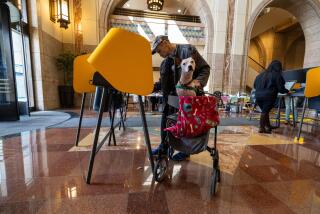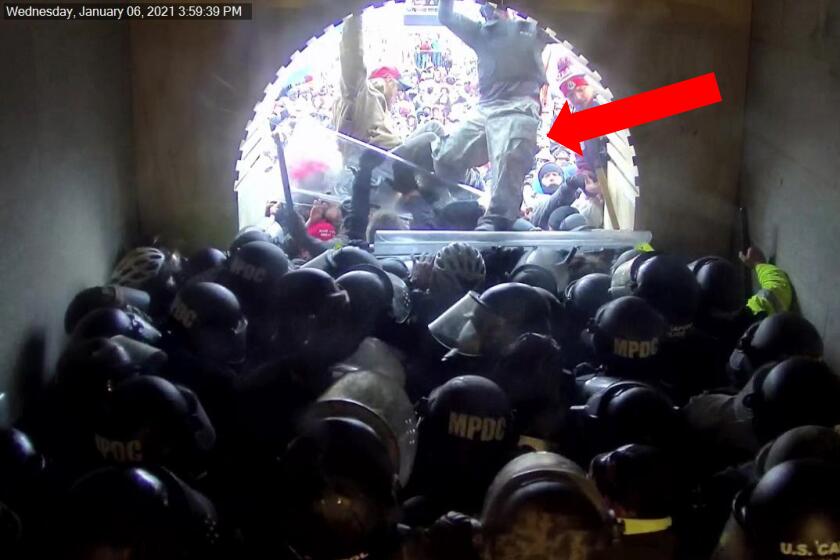California Elections : San Diego Voters Show Confusion on Growth Issues
- Share via
SAN DIEGO — During a recent radio talk show discussion of the many growth-control measures that will appear on San Diego city and county ballots next month, several callers expressed confusion about the various proposals.
Is it Proposition H that places the sharpest restrictions on new housing construction or is it Proposition J? Would Proposition B or Proposition D require local votes on all important land-use decisions? Do any of the measures call upon the city to tear down all its single-family housing and give the former occupants 24-hour seats on the San Diego Trolley?
If these listeners were mixed up, so is much of the rest of the citizenry. On Nov. 8, San Diego voters will be asked to decide four complicated growth-control proposals, along with a fifth advisory measure and 35 other state, county and city propositions.
The outcome will have statewide importance. Builders, developers and their allies defeated a slow-growth initiative in Orange County last June and appear to be headed for another victory next month in Riverside County. If they win in San Diego as well, the statewide slow-growth movement will have lost much of its momentum.
Both supporters and opponents of growth control in the San Diego area fear that voters will be overwhelmed by the number and the complexity of the proposals.
‘Go In and Vote No’
“I worry that the public is going to be so turned off on all these things, they’ll just go in and vote ‘no’ on all of them,” said Bill McNeely, a leader of Citizens for Limited Growth, the slow-growth group that sponsored the two strongest growth-control measures on the ballot.
“I’m always impressed with the public’s ability to go through the initiative process and sort out what they like and don’t like,” said Kim Kilkenny, a leading spokesman for the construction industry. “But this year the challenge is obviously unparalleled.”
Propositions D and J, the “quality of life” measures sponsored by Citizens for Limited Growth, seek to control future population increases by limiting the number of new residential building permits. These limits would continue until major improvements have been made in traffic congestion, air and water quality, sewer capacity and solid waste disposal.
Propositions D and J also would place strict limits on new development in canyons, on hillsides and in other environmentally sensitive lands. Proposition J applies to the City of San Diego, Proposition D to unincorporated county areas.
Proposition H, placed on the ballot by the San Diego City Council, and Proposition B, approved by the county Board of Supervisors, generally are seen as weaker measures that have fewer environmental safeguards and would allow more residential building.
Backers of Propositions B and H say these are “middle ground” responses to two “extremes,” represented by slow-growth advocates on the one hand and uncontrolled development on the other.
But leaders of Citizens for Limited Growth say the City Council and Board of Supervisors measures are “spoiler” propositions that are intended to siphon votes away from Propositions D and J and make it difficult for slow-growth groups to raise money.
Separate growth-control measures will be on the ballot in three other cities in the county--Chula Vista, Encinitas and Poway.
San Diego voters also will be asked to consider Proposition C, which advises but does not mandate the county and its 18 cities to establish a Regional Planning and Growth Management Review Board to deal with growth problems that cross political jurisdictions, as many do.
Behind this flurry of ballot measures lies public uneasiness over rapid growth in the San Diego area and the problems that have followed.
County population, now about 2.3 million, has increased by more than 800,000 in the last 15 years and will leap another 1 million by the year 2010, according to the San Diego Assn. of Governments.
With the growth spurt have come traffic jams, dirty air, overcrowded schools, overburdened sewers, more crime and concern about the future water supply.
It began to occur to many residents of this laid-back land of sunny blue skies and seemingly endless weekends that the worst fate they could imagine--to become another Los Angeles--was approaching fast.
170,000 Signatures
Because the City Council and county Board of Supervisors did not seem to be doing enough to solve the problems, Citizens for Limited Growth launched its initiative campaigns, gathered more than 170,000 signatures and placed Propositions D and J on the ballot.
San Diego builders, developers and businessmen were alarmed.
“I take this as a very serious threat to this community and the people who live here, including my children,” Lee Grissom, president of the Greater San Diego Chamber of Commerce, said in an interview last spring.
Grissom and other business and civic leaders have formed the Coalition for a Balanced Environment, which supports the City Council proposition (H) but has devoted much of its effort to opposing the slow-growth proposal (J).
The coalition has raised about $75,000 so far and is spending it on mailings, radio ads, a speakers’ bureau and what campaign consultant Sara M. Katz called “networking”--distributing employee information kits to every company in the city that employs more than 200 people.
Concentrate on D and J
A second organization--San Diegans for Regional Traffic Solutions, started by a handful of major builders and developers--opposes all four ballot measures but has concentrated its fire on propositions D and J, the Citizens for Limited Growth proposals.
“We’re the group probably most significantly affected by housing caps and ‘sensitive lands’ provisions,” said Mike Madigan, senior vice president of Pardee Construction Co. and spokesman for the group. “We’re viewed as having enormous self-interest in this, and that’s certainly true, but it doesn’t mean we don’t have something of value to say.”
San Diegans for Regional Traffic Solutions has raised $635,000 so far, according to campaign spending reports. Citizens for Limited Growth raised about $100,000 to place their initiatives on the ballot but has received only about $22,000 in contributions for the campaign to date.
“That’s tough to overcome,” said Tom Mullaney, co-chairman of Citizens for Limited Growth. “We’ll rely on peoples’ good sense to realize that developers and politicians are the ones who got us into this mess and they aren’t likely to get us out.”
Opponents of Propositions D and J argue that the slow-growth measures would damage the San Diego-area economy and force up housing prices, while doing little to improve traffic congestion, clean up the air or meet the other “quality of life” standards that are contained in the propositions.
Talk About Housing Caps
Much of the debate so far has been about housing caps. Citizens for Limited Growth say they are needed to slow down a growth rate that saw the City of San Diego issue more than 18,000 new building permits in 1986.
“We need some breathing room,” McNeely said. Proposition J would limit new dwelling units in the city to between 7,000 and 9,000 in the first year, then cut the number until it reached a range of 4,000 to 6,000 units in the fourth year, a level that would be maintained until the year 2010.
For each of the five “quality of life” standards that were met, an additional 400 permits could be issued. However, because three of the standards (traffic congestion, air quality and sewer capacity) seem to be unattainable in the near future, leaders of Citizens for Limited Growth say their proposals would lead to the granting of about 28,400 new permits over a five-year period.
In contrast, Proposition H, the City Council measure, would allow about 38,000 units over five years, without imposing an annual limit. However, H also includes exemptions for redevelopment areas and for low-income housing and those could add up to hundreds or even thousands of additional units each year.
But City Councilman Ron Roberts, the leading spokesman for Proposition H, said 4,000 new dwelling units per year, the minimum that could be allowed under Proposition J, would be a “recessionary” level of new construction that “will hurt this city.”
Impact Anticipated
Other critics of Propositions J and D argue that newcomers will continue to flock to the San Diego area in search of jobs, housing cap or not, and the result will be overcrowding and people living in garages and other sub-standard housing.
Poll Results Not Revealed
Opponents of the slow-growth measures have done some polling but have refused to reveal the results. Other sources, with access to polling conducted for San Diego-area political candidates, say support for Propositions D and J is dropping but still stands at 60% to 65%.
Linda Martin, co-chairman of Citizens for Limited Growth, is pessimistic.
“I think we still have a chance but I’m not as confident as I was a year ago,” Martin said. “The Orange County experience was sobering and . . . I don’t think there’s any way we could have predicted the amount of opposition and the amount of money that would be spent against us.”
More to Read
Get the L.A. Times Politics newsletter
Deeply reported insights into legislation, politics and policy from Sacramento, Washington and beyond. In your inbox twice per week.
You may occasionally receive promotional content from the Los Angeles Times.










